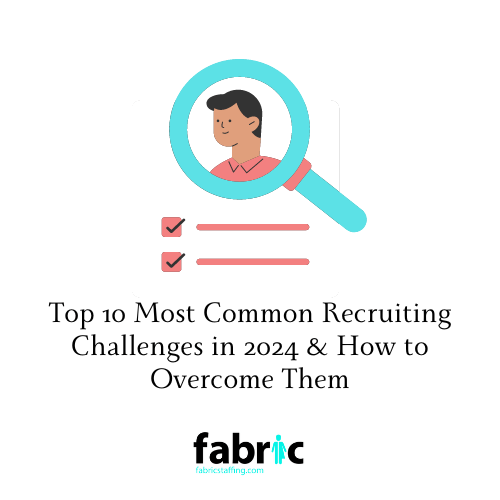Top 10 Most Common Recruiting Challenges in 2024 & How to Overcome Them
The landscape of the staffing industry in 2024 presents a nuanced outlook, characterized by a blend of cautious optimism and adaptation to emerging trends. While challenges persist, the industry has demonstrated resilience, defying initial forecasts of decline. The American Staffing Association (ASA) projects a modest 2.1% revenue increase by the end of 2024, indicating sustained growth albeit at a slower pace compared to previous years.
The Rise of Flexible Work
A defining trend shaping the industry is the rise of flexible work arrangements, including remote and hybrid models. The ASA Staffing Playbook highlights that 44% of workers are willing to trade lower pay for increased job flexibility, underscoring a fundamental shift in work preferences. This evolution aligns with the growing emphasis on work-life balance and offers businesses the opportunity to access talent on a global scale. Consequently, staffing agencies must pivot their strategies to accommodate this demand for flexibility, bridging the gap between clients hesitant to embrace remote staffing and candidates seeking such opportunities.

Increase of the Gig Economy
Against the backdrop of high inflation, a significant portion of the US workforce, comprising 58%, is seeking supplementary income, fueling the expansion of the gig economy. This trend transcends generational boundaries, encompassing Gen X and Baby Boomers, and has prompted businesses to integrate freelance workers into their operations for enhanced agility and cost-efficiency. The temp staffing industry stands poised to capitalize on this shift, offering flexible opportunities and nurturing relationships with freelancers to ensure a steady supply of skilled talent.
Technology and AI Integration
The integration of technology and artificial intelligence (AI) is revolutionizing talent acquisition processes, driving automation and efficiency. AI tools are increasingly utilized for candidate sourcing, resume screening, and video interviewing, streamlining administrative tasks and empowering HR professionals to focus on strategic initiatives. Furthermore, technology facilitates seamless remote onboarding experiences, enabling new employees to integrate into company culture effectively through virtual collaboration platforms.
Upskilling and Reskilling Initiatives
In 2024, companies are urged to prioritize internal talent development through upskilling and reskilling programs, offering employees opportunities for professional growth and advancement within the organization. This strategic focus not only reduces reliance on external hires but also fosters employee engagement and retention. By investing in employee skill development, organizations create a dynamic environment conducive to innovation and adaptability.
Key Statistics of the US Staffing Industry in 2024
- Staffing Market value is projected to reach $207.2 billion, with a growth rate of 2.1%.
- Temp staffing recruitment dominates the industry, accounting for 89% of the market, with the IT and Tech sector leading at a value of $43.2 billion.
- Industries experiencing significant growth include leisure and hospitality, health care and social assistance, and professional and business services, highlighting diverse opportunities within the sector.
As organizations navigate through economic uncertainties and technological advancements, the quest for talent acquisition and retention remains paramount. From attracting qualified candidates in a competitive market to embracing flexible work models and integrating cutting-edge technology, the path to building high-performing teams is multifaceted. By understanding and addressing the top recruiting challenges of 2024 head-on, businesses can position themselves not only to survive but to thrive in a rapidly evolving global marketplace.
This article explores the ten most common challenges facing recruiters and employers today and offers practical strategies to overcome them, empowering organizations to build resilient, diverse, and agile teams poised for success in the years ahead.

1. Attracting Qualified Candidates
Challenge: 77% of employers struggle to find qualified candidates. The right mix of hard and soft skills, alignment with company values, and cultural fit is hard to come by.
Solution: Optimize job ads for SEO on your website and social media. Publish creative content on social media, as 73% of millennials found their jobs through social platforms last year. Clearly communicate job requirements, expectations, and the hiring process to manage candidate expectations effectively. Utilize qualified recruiters who specialize in your industry.
2. Building a Strong Employer Brand
Challenge: 75% of candidates consider a company’s employer brand before applying. A weak employer brand can deter top talent.
Solution: Highlight employee testimonials and create employee-centered content on social media. Simplify the application process by skipping cover letters and utilizing LinkedIn integrations. Streamline your application process to make it easy and appealing for candidates.
3. Reaching Passive Candidates
Challenge: 70% of the workforce comprises passive candidates who are not actively seeking new jobs but may consider the right opportunity.
Solution: Attend relevant industry events to meet potential candidates. Use specialized recruiters or agencies, like Fabric Staffing, to identify top talent. Reach out to passive candidates via LinkedIn InMail with personalized messages explaining why you are contacting them.
4. Reducing Candidate Dropoff
Challenge: 92% of candidates who start their job applications do not finish them due to complex and lengthy application processes.
Solution: Simplify the application process by removing unnecessary steps. Implement skills assessments early in the process to engage candidates and provide timely and continuous communication about their application status.

5. Eliminating Hiring Bias
Challenge: 89% of hiring managers make quick judgments about candidates, leading to biased and often poor hiring decisions.
Solution: Ensure structured interviews and blind resume reviews to minimize biases. Use AI tools for creating neutral job descriptions and candidate assessment tools that focus on skills over personal attributes.
6. Accurately Assessing Candidate Skills
Challenge: Sophisticated applicant tracking systems and AI tools cannot always verify candidates’ skills and their ability to apply them effectively.
Solution: Use skills assessment tools to test both hard and soft skills early in the recruitment process. Utilize recruiting services like Fabric Staffing who have recruiters that have years of experience in hiring within your specific industry.
7. Personalizing Candidate Communication
Challenge: 54% of candidates abandon the recruitment process due to poor communication from recruiters.
Solution: Automate parts of the communication process while maintaining a personal touch. Use templates and reminders for different stages of the application process to ensure timely and relevant communication with candidates. Good recruiters will always follow up without having to be asked.
8. Reducing Time to Hire
Challenge: The average time to hire was 44 days in 2023, making it crucial to reduce this duration to avoid losing top talent.
Solution: Set clear hiring timelines and empower hiring managers to make swift decisions. Use applicant tracking systems to efficiently manage and communicate with candidates. Look for recruiting partners that specialize in rapid hiring strategies like Fabric Staffing.
9. Reducing Hiring Costs
Challenge: The average cost per hire in 2023 was over $4,700, with additional costs if re-hiring is necessary due to a bad hire.
Solution: Promote internally and build referral programs to reduce hiring costs. Leverage modern AI hiring tools to identify the best candidates early and minimize resource expenditure on unsuitable candidates. Working with subscription-based staffing services like Fabric Staffing can reduce your hiring costs by 80%, compared to contingent firms.
10. Inconsistent Training for Hiring Managers
Challenge: Inadequate training for hiring managers can lead to poor hiring decisions and increased costs.
Solution: Provide regular training sessions on DEI best practices and legal compliance. Standardize the recruitment process to ensure fairness and efficiency. Work with multiple recruiting agencies and learn strategies that best fit your hiring environment.
Experience the Fabric Staffing Difference
At Fabric Staffing, we understand the complexities of the recruitment process and are dedicated to helping our partners overcome these challenges. By leveraging our specialized services, such as Rapid Growth Hiring, Executive Search, Recruiter on Contract, and Recruitment Process Outsourcing, we provide personalized and practical solutions tailored to your unique needs.
Join the ranks of our successful partners, including Twitter (X), Discord, Google, Headspace, Snap, and many more. Let us help you build high-quality teams of diverse talent that drive innovation and success.
Contact us today to learn more about how we can support your recruitment efforts in 2024 and beyond.










